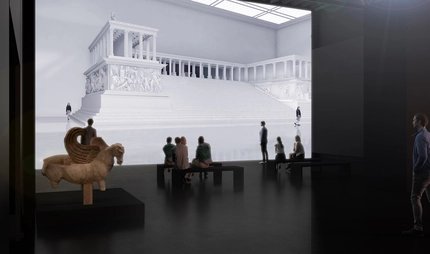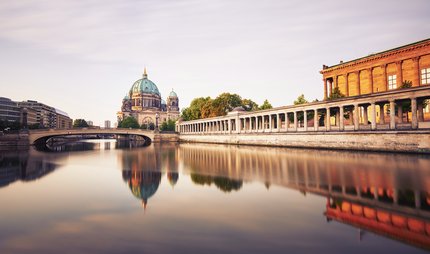
Museum für Islamische Kunst, Pergamonmuseum
The Pergamon Museum is closed for renovation
Please note: The Pergamon Museum, and therefore also the Museum of Islamic Art, has been closed since October 2023.
Spain, Egypt, Iran and India - The Museum für Islamische Kunst at Pergamonmuseum guides you through these centres of historic importance. From the first Caliphs in the 7th century to the 19th. You will find the collection in the Pergamon Museum on Berlin's impressive Museumsinsel (Museum Island). The Pergamon is internationally renowned as the oldest and most important museum of its kind - not least due to the imposing facade of the Palace of Mshatta, a gift from the Ottoman Sultan to the German Emperor. Smaller treasures include velvet fabrics, pottery and valuable carpets in fine patterns and bright colours. The famous Aleppo Room is decorated with original wood panelling from the year 1600.
A collection of tradition
"The Bismarck of the Berlin museums", Wilhelm Bode establishes an Islamic Art Department in 1904. It is first housed in the Bode-Museum but is transfed to the Pergamon Museum in 1932, thereby belonging to the Berlin State Museums. The cornerstone of the collection is the Mshatta Facade - a gift from Abdul Hamid II to Kaiser Wilhelm II. Significant parts are destroyed during the war, including a tower of the Mshatta facade. In 1954, the collection is divided between West and East Berlin, and reunited in 1992. Since 2000, visitors have been able to see the full collection at the Pergamon Museum. The tour takes you chronologically through the exhibition, beginning with the great Caliph empires. Discover excavation finds from the rich city Samarra on the Tigris River. Further along you stand before the imposing stone facade of the Mschatta Palace, an 8th century residence from Jordan. The filigree reliefs are a well preserved architectural specimen. A path leads you through the 11th to 15th centuries. Discover a painted turquoise prayer niche from Anatolia and a detail of the carved dome of the Alhambra in Granada. The Aleppo Room dates from the early modern period: its ornate paintings and wood panelled walls are made for a Christian merchant. Discover changing exhibitions on binding, calligraphy and Koranic scriptures in the book museum.
Arts and crafts in the Museum für Islamische Kunst at Pergamonmuseum
- Koran folding panel from Konya (13th century)
- Ivory signal horn with decor from Sicily (11th or 12th century)
- Prayer niche (Mihrab) from Iran with filigree decoration (1226)
- Large Koran with calligraphy from Cairo (circa 1300)
- Carpet with Dragon Phoenix motif, Turkey (15th century)
Exhibitions in the vicinity
The Museum für Islamische Kunst has its origin in the Bode-Museum. Today it houses a collection of sculpture, the Museum für Byzantinische Kunst and the Münzkabinett. Highlights include ancient sarcophagi from Rome and sculptures by Tilman Riemenschneider.
Tips and advice for your visit
Arrive at the Museum für Islamische Kunst at Pergamonmuseum comfortably via the S and U-Bahn. Alight at Friedrichstraße train station via the U6, the S2 and S7. From here it's only a ten minute walk.
Tuesday to Sunday 9am - 7pm.
Thursday 9-20 h.
Monday closed.



